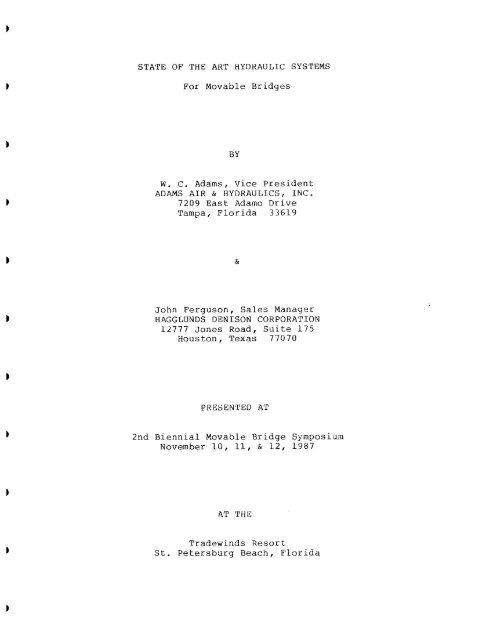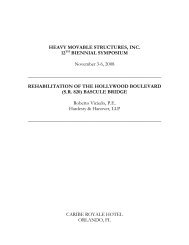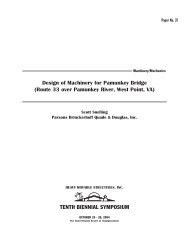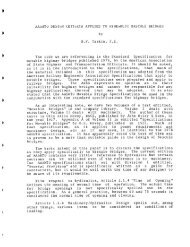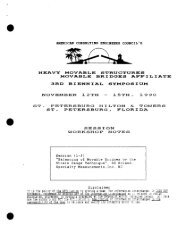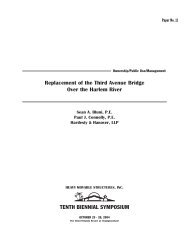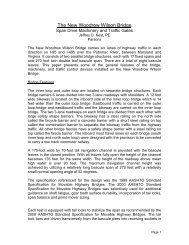State of the Art Hydraulic Systems for Movable Bridges
State of the Art Hydraulic Systems for Movable Bridges
State of the Art Hydraulic Systems for Movable Bridges
Create successful ePaper yourself
Turn your PDF publications into a flip-book with our unique Google optimized e-Paper software.
I. HISTORY OF HYDRAULICS:<strong>Hydraulic</strong>s date back to <strong>the</strong> pyramids and Egyptians. Thismeans <strong>of</strong> power transmission became popular during World War11, when it was mass produced <strong>for</strong> <strong>the</strong> military. This paperdeals with modern, state oE <strong>the</strong> art hydraul~cs sprcirically<strong>for</strong> movable bridges.b11. EVERYDAY USE - OF HYDRAULICS WE ARE ALL FAMILIAR WITH:<strong>Hydraulic</strong> brakes on automobiles and o<strong>the</strong>r vehicles were atone time completely mechanical. These systems were changedover to hydraulics in <strong>the</strong> '30's. <strong>Hydraulic</strong>s are more flexibleand much more reliable. Then came hydraulic steeringwhich is more popular today <strong>the</strong>n anytime in history. It issafe to say that all in attendance here today have hydraulicsteering and brakes on <strong>the</strong>ir automobiles. Every modernjetliner today depends on hydraulics, <strong>for</strong> <strong>the</strong>ir flightcoritrol, steering, brakes, and landing gear. The entirespace program is dependent upon this technology <strong>of</strong>hydraulics, commonly referred to as fluid power.111. MOVABLE BRIDGES: -- --When contemplating <strong>the</strong> very size <strong>of</strong> a movable bridge, onewould note at <strong>the</strong> outset that <strong>the</strong>re exists a requirement <strong>for</strong>smooth precise controllability. This as well as o<strong>the</strong>rparameters <strong>of</strong> <strong>the</strong>ir operation is very easily accomplished byfluid power systems. Most all engineering projects, thatclepend on extreme reliability, have specified hydraulicdrives <strong>for</strong> <strong>the</strong> past fifty or so years.The parameters <strong>for</strong> most movable bridges, easily accomplishedwith fluid power systems are:(a) Smooth and accurate acceleration and deceleration;(b) Positive locking in any position;(c) Driving endlocks or pins;(dl Capable <strong>of</strong> handling variable loading (wind, ice,etc. )An inherent advantage in hydraulic systems, that can beadvantageous to <strong>the</strong> design engineer, is that systemcomponents have an excellent power to weight ratio.Compared to electro mechanical components, <strong>the</strong>y are smaller,lighter, easier to service, and in general are standardstock items available most anywhere.
Page 2~ost common means <strong>of</strong> powering movable bridges with fluidpower are:(a) <strong>Hydraulic</strong> cylinder(s) = linear motion;(b) ~ydraulic motor(s) = rotary motionEi<strong>the</strong>r means has its own unique features and both can bedepended upon to deliver about <strong>the</strong> same degree <strong>of</strong> reliablityand accuracy. The very function <strong>of</strong> <strong>the</strong> bridge itself willindicate which system you should select. Ei<strong>the</strong>r system canbe designed so that it is impervious to its environment.The retr<strong>of</strong>it <strong>of</strong> aged bridges with mechanical drives tomodern state <strong>of</strong> <strong>the</strong> art hydraulic operation is <strong>the</strong> shortestroute to life extension <strong>of</strong> <strong>the</strong> installation, and <strong>the</strong>installed cost is much lower than purchasing replacements<strong>for</strong> older mechanical drives in most cases. Most retr<strong>of</strong>itsbecome permanent installations, once <strong>the</strong> operator hasexperienced <strong>the</strong> controllability. As stated earlier, <strong>the</strong>high power to weight ratio <strong>of</strong> fluid power systems can, insome cases, allow <strong>the</strong> installation to be made along sideexisting mechanical systems, <strong>for</strong> increased serviceability orto add to <strong>the</strong> redundancy <strong>of</strong> <strong>the</strong> overall system.IV. HYDRAULIC MOTORS:~f a drive is under consideration <strong>for</strong> a new or retr<strong>of</strong>itapplication, one must consider <strong>the</strong> drive shaft or piniontorque or horsepower. Here we are dealing primarily withshaft torque. <strong>Hydraulic</strong> motors that are available todayfall into three basic categories:fa) High speed/low torque = 500 - 3600 R.P.M.cases require a speed reducer.)(Will in most(b) Low speed/high torque = 10 - 500 R.P.M. (Develops sevento nine power strokes per revolution and may require aspeed reducer.)(c) LOW speed/high torque = 0 - 50 R.P.M. (Develops up toone hundred twenty power strokes per revolution andwill not require a speed reducer.)It should be noted that on retr<strong>of</strong>it bridge applications asmaller motor may possibly be applied to existing gearing.If this is <strong>the</strong> option, in most cases it may be possible toreduce input horsepower by approximately 20% due to <strong>the</strong> highstarting torque characteristic <strong>of</strong> high torque/low speedmotors as mentioned in tc) above.
Page 3HYDRAULIC CYLINDERS:The application <strong>of</strong> hydraulic cylinders to operate movablebridges has been <strong>the</strong> most widely acceptable to date. Be itlift, swing type, or bascule design, cylinders can easily beinstalled on both old and new bridges. Two cylinders perspan are normally required; however, any number is possible.There are basically two types <strong>of</strong> cylinders available <strong>for</strong>movable bridges, welded and tie rod design. There is a widevariety <strong>of</strong> mounting styles. Most common are sphericalbearing clevis, both ends and intermediate trunnion. Thetie rod designs are inexpensive and are used in manydifferent industry applications because, regardless <strong>of</strong>manufacturer, <strong>the</strong>y are all dimensionally interchangeable.The welded type hydraulic cylinder is so constructed that itcan be serviced in place even after years <strong>of</strong> exposure, andgenerally, stainless steel piston rods are standard whereas<strong>the</strong> tie rod design most <strong>of</strong>ten requires that you order stainlesspiston rods speciEically as most manufacturers do not<strong>of</strong>fer stainless steel rods as standard. For civil engineeringprojects stainless steel, chrome plated piston rods are<strong>the</strong> optimum.'$1.PROPORTIONAL VALVES:Controlled acceleration and deceleration are extremelycritical to <strong>the</strong> safety requirements in bridge operationsince oil flow equals speed. This is accomplished byincreasing or decreasing oil flow to <strong>the</strong> hydraulic cylinder(~).This is accomplished by using todays proportionaldirectional control valves. These are extremely rugged andversatile valves that operate from a proportional <strong>for</strong>cecoil. The <strong>for</strong>ce controlled servo mechanism, an int.egra1part <strong>of</strong> <strong>the</strong> directional control itself, provides an adjustable<strong>for</strong>ce output proportional to <strong>the</strong> amount oE DC currentbeing applied. Typical power supply is 0 - 9 volts DC/800miliamps.The adjustable <strong>for</strong>ce delivered from <strong>the</strong> servo is used tovary <strong>the</strong> travel <strong>of</strong> <strong>the</strong> valves main spool. This spool is sodesigned to <strong>of</strong>fer excellent metering <strong>of</strong> <strong>the</strong> hydraulic flu~d,both to and from <strong>the</strong> cylinder(s). Thus <strong>the</strong> cylinder(s)speed becomes infinitely variable.
Page 4Electronic amplifier cards are used to control current to<strong>the</strong> proportional servo. Cards are standard items andcontain adjustable ramp circuits. The ramp feature gives anadjustable acceleration/deceleration no matter how abrupt<strong>the</strong> command. If applied with <strong>the</strong> "nearly open/nearlyclosed" limit switches, <strong>the</strong> bridge will automaticallydecelerate. This system could be applied with a programmablecontroller or very simple "raise/lower" push buttons at<strong>the</strong> control console.VII.COUNTERBALANCE VALVES:Since a movable bridge must be capable <strong>of</strong> handling varyingloads, a hydraulic drive system is <strong>the</strong> best possiblesolution. Ice loading and high winds can contribute to aspan becoming unbalanced and create a run-away condition.In open loop cylinder circuits, a component known as acounterbalance valve prevents this from occuring. Evenwithout <strong>the</strong> use <strong>of</strong> a counter weight, a counterbalance valvewill provide smooth control <strong>for</strong> lowering <strong>the</strong> span.In addition <strong>the</strong> counterbalance valves will hold <strong>the</strong> bridgefirmly in any position. The function <strong>of</strong> <strong>the</strong> valve is tolock oil in <strong>the</strong> cylinders until piloted open by pressurefroin <strong>the</strong> opposite direction. Should unexpected high windsoccur greater than <strong>the</strong> holding <strong>for</strong>ce, integral relief valveswill relieve <strong>the</strong> excessive load safely.~111. ERAULIC PUMPS:Todays hydraulic pumps are available in a wide variety <strong>of</strong>types and sizes, enabling <strong>the</strong> designer to "tailor" a specificpump <strong>for</strong> a specific application to ensure proper per<strong>for</strong>manceand long life.~ost comrnon varieties <strong>of</strong> pumps available today are:(a) Axial piston, variable & fixed volume, open or closedloop.(b) Vane pumps, variable & fixed volume, open loop.(c) Gear pumps, fixed volume, open loop.Axial piston designed pumps are <strong>the</strong> most energy efficient <strong>of</strong>all pumps available today. Pressures range up to 6000 psi.There is really no limit to <strong>the</strong> control options available,especially in <strong>the</strong> hydrostatic closed loop versions whichinclude manual, horsepower limitinq, neutral brake & by-passcontrol, horsepower summation and electroservo to name afew.
Page 5BIX.These pumps function extremely well with ei<strong>the</strong>r high speed/low torque or high torque/low speed motors. In ei<strong>the</strong>r case,all system valving is integral to <strong>the</strong> pump or motor whichmake system installation easy. In addition to this feature,closed loop pumps require far less oil reservoir capacity.with state <strong>of</strong> <strong>the</strong> art controls <strong>the</strong>y lend <strong>the</strong>mselves wellsuited to movable bridge applications in conjunction withhigh torque/low speed motors where failsafe brakes arerequired, <strong>the</strong>ir controls adapt well to process controllers.Open loop pumps draw oil dlrectly from <strong>the</strong> oll reservoir,and unlike closed loop pumps, <strong>the</strong>y can pump oil in only onedirection. They require directional control valves to port<strong>the</strong> hydraulic orl to and from <strong>the</strong> hydraulic cylinders. Withthis type <strong>of</strong> pump, external relief valves, and counterbalancevalves, are also required. The above statementdeals with fixed volume vane type pumps only. This type <strong>of</strong>pump can be obtained in single, double to triple pumpconfigurations. It can also be config-xed to "piggyback" anopen loop axial piston pump with various control options <strong>for</strong>special applications, pressures range up to 5000 psi.Variable volume vane pumps are limited on both controls andpressure, 1000 psi generally being <strong>the</strong> highest pressureavailable. We could not recommend this type <strong>of</strong> pump <strong>for</strong>movable bridge applications.Gear type pumps are <strong>the</strong> least efficient <strong>of</strong> all <strong>the</strong> pumps wehave discussed. Their inherent design commits <strong>the</strong>m togenerating continuing amounts <strong>of</strong> metallic particles into <strong>the</strong>hydraulic system. Again we could not recommend this type <strong>of</strong>pump <strong>for</strong> movable bridge applications. Its main function isto power hydraulics <strong>for</strong> mobile and agricultural machinery.HYDRAULIC FLUIDS AND FILTRATION:~t this point, it is probably best to say a little abouthydraulic fluids. We call <strong>the</strong>m petroleum "fluids" ra<strong>the</strong>rthan "oils" to emphasize that it is a special <strong>for</strong>mulationwith <strong>the</strong> additives to make it suitable as a hydraulic fluid.Primarily, <strong>the</strong>se additives inhibit or prevent rust,oxidation, foam, and wear.
Page 6There are three common grades <strong>of</strong> "anti-wear" hydraulicfluids.GENERALNOKMAI,IS0 GRADE VISCOSITY OPERATING TEMP.LIGHTMEDIUMHEAVYMost bridge systems do not cycle enough to heat <strong>the</strong> fluidabove about LIO°F, obviously, <strong>the</strong> heaviest fluid provides<strong>the</strong> best lubricating ability; but it may require a tankheater <strong>for</strong> cold wea<strong>the</strong>r operation.The proper filtration <strong>of</strong> <strong>the</strong> fluid is essential to <strong>the</strong>survival <strong>of</strong> a hydraulic system. A ten (10) micron filter isgenerally considered adequate <strong>for</strong> fluid used in pistonpumps. The relative size <strong>of</strong> a particle this small is hardto comprehend since <strong>for</strong>ty 140) microns is <strong>the</strong> lower l i m i t <strong>of</strong>human visibility. A ten (10) micron particle is about <strong>the</strong>size <strong>of</strong> a red blood cell!The standard, by which all hydraulic filter elements arerated, is <strong>the</strong> "Beta Ratio" system. This system classifiesfilter elements by <strong>the</strong>ir efficiency at removing a certainparticle size. A simple test is per<strong>for</strong>med by introducingparticles <strong>of</strong> known quantity and size up stream <strong>of</strong> <strong>the</strong>element and recording <strong>the</strong> number that pass throughdownstream. By dividing <strong>the</strong> upstream particles by <strong>the</strong>number downstream, a Beta Ratio can be determined. Ten (10)micron filters with a Beta ratio <strong>of</strong> 50 are good costeffective filtration.
Page 7BETAX = UPSTREAM = - 100 = 502DOWNSTREAMBETA RATIO NUMBERBETA RATIO VS. EFFICIENCY --BETA % EFFICIENCY -Many hydraulic component manufacturers oEfer hydraulic oiltest kits, as well as some oil companies. This kit issimple to use and <strong>the</strong> owner/operator can make periodicanalysis <strong>of</strong> his fluid to determine its condition.X. SYSTEM - INSTALLATION:Now that we have taken a look at acceptable hydraulic Eluiasand filtration requirements, <strong>the</strong> next step is to consider<strong>the</strong> oil reservoir and interconnecting lines. To insure thatyou are getting a clean system to begin with, a good deal <strong>of</strong>care should be taken in <strong>the</strong> design and fabrication <strong>of</strong> <strong>the</strong>reservoir itself. After construction, it should be cleaned<strong>of</strong> all welding slag, blasted, and its interior coated toprevent rust. Once this important step is complete, <strong>the</strong>reservoir should be filled with clean oil filtered to atleast ten micron.
Page 8All hydraulic lines should be cleaned and flushed using <strong>the</strong>same hydraulic fluid that will be used in <strong>the</strong> system. Theflushing oil velocity should be <strong>the</strong> same as <strong>the</strong> systemdesign parameters.XI.PLUMBINeThe plumbing <strong>of</strong> <strong>the</strong> hydraulic system should be done by apr<strong>of</strong>essional, many <strong>of</strong> whom are in this type <strong>of</strong> business,ra<strong>the</strong>r than a local pipe fitter who is unfamiliar withhydraulic systems. The use <strong>of</strong> black iron pipe is discouragedas well as <strong>the</strong> use <strong>of</strong> galvanized fittings on <strong>the</strong>low pressure side <strong>of</strong> <strong>the</strong> system. Both types are known torust quite easily and flake away material internally.Stainless steel tubing specifically <strong>for</strong> hydraulic systems is<strong>the</strong> optimum solution with 37 degree flares or "o" ring sealSAE fittings at all pump, motor, valves, & cylinder ports.Todays systems incorporate many modular valve systems andmanifolds which accomplish two things at once, <strong>the</strong>ir usemakes servicability simple and eliminates a good deal <strong>of</strong>plumbing. If hydrualic hose is being considered pleaserefer to <strong>the</strong> SAE hose specifications which contain detailson ratings, hose sizes, and bending radius. Again, as withstainless steel hydraulic tubing, 37 degree flares or "o"ring seal connections are considered <strong>the</strong> optimum solution toensure a leak free system.Considering all that we have discussed in this paper, onewould be led to believe that hydraulic systems must beextremely complicated. On <strong>the</strong> contrary, <strong>the</strong>re exists noblack magic. <strong>Hydraulic</strong> systems <strong>of</strong> today are relatively easyto design, easy to install and come wit'7 many built-infeatares that reduce or eliminate <strong>the</strong> need <strong>for</strong> maintenance.They are quiet, energy efficient and provide superior liEeover that <strong>of</strong> electro mechanical drives.Most <strong>of</strong> us have witnessed <strong>the</strong> pitiful spectacle <strong>of</strong> a noisy,leaking hydraulic system with at least one mile <strong>of</strong> poorlyinstalled pipes that vibrate and leak. Those days are gone<strong>for</strong>ever with tomorrow's hydraulics available today. As afinal thought it is <strong>the</strong> prudent engineer, owner or operatorwho looks to <strong>the</strong> designer who can <strong>of</strong>fer one source, oneresponsibility capability. This ensures that allcomponentry is guaranteed to work in harmony.


